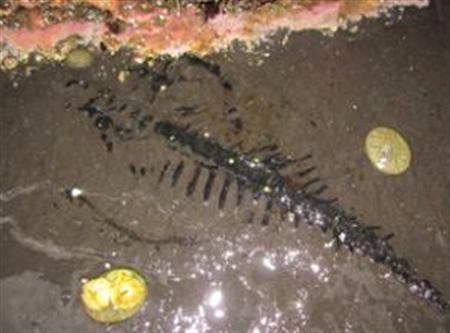一些科学家近期在美国阿拉斯加州南部发现一组史前海洋爬行类动物化石。它可能是迄今保存最为完整的爬行类动物化石。

长尾海龙类爬行动物化石
这组化石属于一种长尾海龙类爬行动物。它们出现在恐龙之前,在浅水区生活,于2亿年前三叠纪晚期灭绝。
路透社7月28日报道,今年6月,一些地理学家在阿拉斯加州南部通加斯国家森林实地考察时恰遇退潮,无意中发现这组化石。阿拉斯加大学北方博物馆本周发布这一消息。
考察组成员、美国地质学家吉姆·贝沙塔尔说:“我们当时正在喝咖啡,突然一个人说,‘那是什么’?”
贝沙塔尔说,先前发现的海龙类化石大多零散,只有某一部分骨骼,但这组化石几乎涵盖完整的骨架结构。
“在北美,这可能是我们拥有的最具说服力的标本,”他说,这可能是人类先前没有发现的海龙类物种。
加拿大和中国等地先前曾出土海龙类爬行动物化石。一些科学家将返回通加斯国家森林,进一步搜寻埋藏在沙滩岩石下的其他化石部分。
生物探索推荐英文原文
Rare fossil of sea reptile found on Alaska beach
Alaska scientists have discovered the fossil of a rare, prehistoric marine reptile that is likely the most complete remnant of the creature ever found in North America.
The nearly complete fossilized skeleton is of a thalattosaur, a long-tailed sea creature that plied warm, shallow waters in the early days of dinosaurs and became extinct at the end of the Triassic period some 200 million years ago.
The discovery of the fossil, found during an extreme low tide along the shore of the Tongass National Forest, was announced this week by the Museum of the North at the University of Alaska, Fairbanks.
"We were just having our morning coffee out on the outcropping when somebody said, 'What's that?'" Jim Baichtal, the U.S. Forest Service's Tongass geologist and part of the discovery team, said on Thursday.
Geologists had been conducting field surveys at the site when the fossil was spotted.
Unlike most thalattosaur discoveries, which are fossilized remnants of individual bones and bone fragments, this specimen appeared to be a nearly full skeleton.
"In North America, this may be the most articulated specimen that we have right now," Baichtal said.
Scientists excavated the fossil in June and have been studying it to determine whether it represents a previously unknown species.
There are only about a dozen full thalattosaur specimens in the world, Baichtal said. "So the probability of this being something that wasn't seen before is probably pretty high," he said.
The find is likely the most northern discovery as well, Baichtal said. The fossil was found near the Tlingit Indian village of Kake in southeast Alaska.
Other thalattosaur discoveries have been made in British Columbia, Canada, as well as in Nevada and the Alps, though the best finds have been made in China, he said.
SITE WAS TROPICAL
At the time this particular animal was trapped in sediment, about 200 million to 220 million years ago, the site was close to the equator and tropical, Baichtal said.
"This was a warm, volcanic island with reefs surrounding it," similar to Hawaii, he said. Plate tectonics eventually sent the site drifting north to its present location in Alaska, he said.
The fossil from the Tongass beach is now at the Museum of the North, where scientists will do further work to separate the rock from the bone.
Thalattosaurs inhabited the seas for about 30 million years, a relatively brief time geologically, said Pat Druckenmiller, earth sciences curator for the Museum of the North. They measured about three to 10 feet long, with half to a third of that taken up by the tail, he said.
"The rest of its body would be kind of reminiscent of a big lizard," he said, with legs modified to work as paddles.
Some had no teeth, some had pointy teeth that might have been useful for spearing fish, and some had flat teeth that might have been used to crush shells, Druckenmiller said.
The Alaska fossil appears to include the outline of soft-body tissue that surrounded the bone.
"That's really rare," Druckenmiller said. "That might give us some idea of what the actual body shape was."
Scientists will return to the site later to try to excavate the rest of the fossil, still embedded in beach rock, Druckenmiller said.
"We don't know if the skull will be there or not, but I have high hopes that it will be there," he said.
(Editing by Steve Gorman and Cynthia Johnston)







